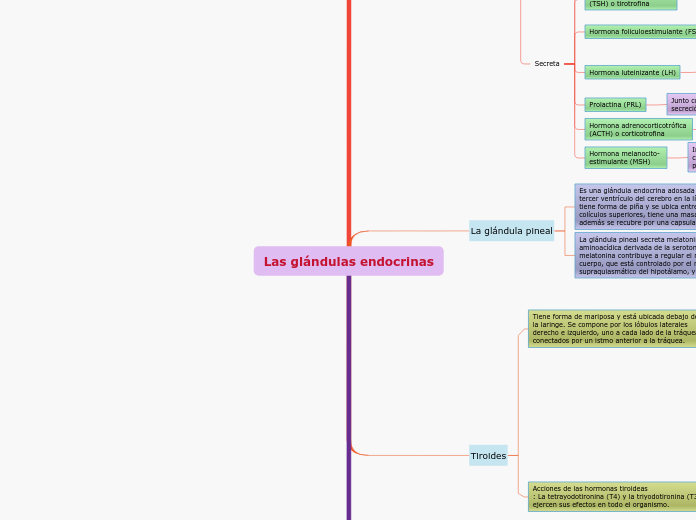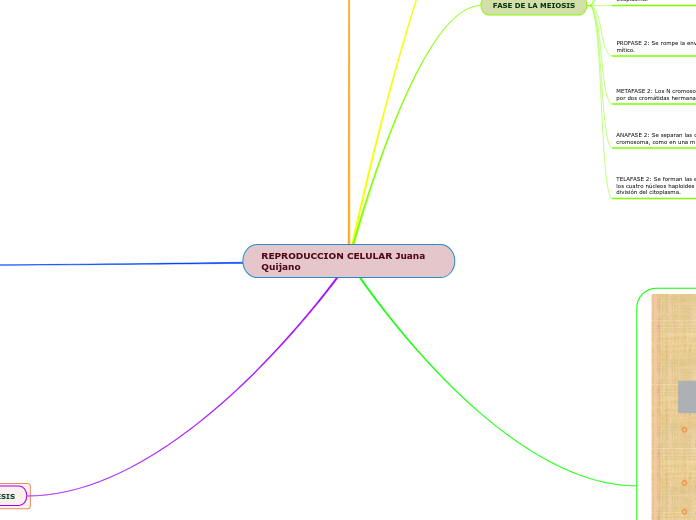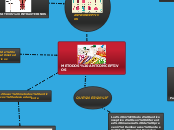Las glándulas endocrinas
To name your story, you have to think about the overall message and what you want your audience to understand from the story. Also, make it relevant and easy to remember.
Paratiroides
Hormona paratiroidea (PTH) de las células principales
Aumenta los niveles sanguíneos de Ca2+ y Mg2+ y disminuye el nivel sanguíneo de HPO42–, aumenta la resorción ósea por los osteoclastos, aumenta la reabsorción de Ca2+ y la excreción de HPO42– por los riñones y promueve la formación de calcitriol (forma activa de la vitamina D), el cual aumenta la tasa de absorción del Ca2+ y Mg2+ de la dieta.
A nivel microscópico, la paratiroides tiene 2 clases de células epiteliales
También, las células oxífilas secretan PTH, en un cáncer de las glándulas paratiroides.
Las células principales y más numerosas, producen hormona paratiroidea (PTH), o parathormona, y las células oxífilas que ayuda a identificar la glándula paratiroides en el análisis histopatológico, pero se desconoce su función en específico.
Están rodeadas parcialmente por la cara posterior de los lóbulos laterales de la glándula tiroides y hay masas pequeñas denominadas glándulas paratiroides.
Cada glándula, tiene una masa cerca de 40 mg. En general, hay una glándula paratiroides superior y una inferior adosadas a cada lóbulo tiroideo lateral, para un total de 4.
Tiroides
The ending of a story is essential. We all know that if the ending is weak, what happened before loses its importance. So make it unpredictable, but fair. A resolved ending answers all the questions and ties up any loose threads from the plot.
Acciones de las hormonas tiroideas
: La tetrayodotironina (T4) y la triyodotironina (T3) ejercen sus efectos en todo el organismo.
This is the closure section of the story.
See examples of possible outcomes below:
- all problems have been solved
- it's clear how each one of your characters ends up
- your main character is transformed by the challenge
5) En unión de la hormona de crecimiento humano y la insulina, aceleran el crecimiento corporal, en particular el crecimiento del sistema nervioso y el sistema esquelético. Un déficit de estas hormonas podrían ocasionar retraso mental en la niñez.
4) Potencian algunas acciones de la adrenalina y noradrenalina porque regulan el incremento de los receptores beta (β).
3) Estimulan la síntesis de proteínas y aumentan el empleo de glucosa y ácidos grasos para la producción de ATP, durante regulación del metabolismo, además aumentan lipólisis y aceleran la excreción de colesterol.
Try answering these questions in order for you to come up with a closure:
- Have all problems been solved?
- Is it clear what happens with all your characters in the story?
- Has the challenged transformed your main character?
- How do the characters feel in the end?
2) Estimula la síntesis de bombas de sodio-potasio adicionales (ATPasa Na+/K+), lo cual implica mucho gasto de ATP, lo cual se ocurre el fenómeno denominado efecto calorigénico, ya que el calor se libera y la temperatura corporal aumenta. Así es, como estas hormonas ayudan en la constante temperatura corporal.
1) Las hormonas tiroideas aumentan el índice metabólico basal o metabolismo basal, estimulando el uso de oxígeno celular para producir ATP, a su vez aumenta el metabolismo celular de hidratos de carbono, lípidos y proteínas aumenta.
Try answering these questions to come up with a closure:
- Have all the problems been solved?
- Is there a clear picture of what happens with each character in the story?
- Has the challenge transformed your main character?
- How do the characters feel in the end?
Tiene forma de mariposa y está ubicada debajo de la laringe. Se compone por los lóbulos laterales derecho e izquierdo, uno a cada lado de la tráquea, conectados por un istmo anterior a la tráquea.
This is the moment when the main character surpasses the last obstacle and finally faces their greatest challenge.
The climax usually follows one of these patterns:
- realization
- resolution
- choice
Type in your answer.
Las células foliculares producen 2 hormonas: la tiroxina o tetrayodotironina (T4) y la triyodotironina (T3). En los folículos se hallan las células parafoliculares o células C que producen la hormona calcitonina.
Los folículos tiroideos forman la mayor parte de la glándula tiroidea. La pared de cada folículo posee células llamadas células foliculares y una membrana basal recubre cada folículo.
La glándula pineal
The middle of the story is where you add layers of complications that will lead to the end. Reveal more about the character's journey. Did their personality go through changes? How did they overcome the challenges? And as you build up the story’s central conflict, make it more personal to that character. Also, from the middle act, you have to lead into the final act.
La glándula pineal secreta melatonina, una hormona aminoacídica derivada de la serotonina. La melatonina contribuye a regular el reloj biológico del cuerpo, que está controlado por el núcleo supraquiasmático del hipotálamo, y facilita el sueño.
Your character(s) need(s) motivation in order to solve the challenge(s).
Como respuesta al estímulo visual desde la retina, el núcleo supraquiasmático estimula las neuronas simpáticas posganglionares, que a su vez estimula a los pinealocitos de la glándula pineal para secretar melatonina y disminuye en el dia.
Why does your character need to confront this challenge? What does he/she expect to accomplish by solving it?
See a few examples:
- will marry in 3 days
- can fix the mistakes of the past
Ademas, la melationina puede ser un antioxidante potente que provee un poco de protección frente a los nocivos radicales libres del oxígeno.
Es una glándula endocrina adosada al techo del tercer ventrículo del cerebro en la línea media, tiene forma de piña y se ubica entre los 2 colículos superiores, tiene una masa de 0,1-0,2 g, además se recubre por una capsula de piamadre.
Each story has a main character and that character usually needs to solve a problem or challenge. The character's challenge is the one that creates tension throughout the story.
La glándula consiste de masas de neuroglía y células secretoras denominadas pinealocitos.
In most stories, there are 3 challenges. The number 3 is a mystical number symbolizing completeness. Try to come up with interesting challenges with which your character needs to struggle.
See a few examples below:
- turns into a werewolf at night
- is sent back in time
Hipófisis
In the beginning of the story (or the exposition), you will need to introduce the setting and characters. You might also want to introduce the main conflict. This part of the story is important because it gives the reader necessary background information and maybe even a first insight into a character’s personality.
Secreta
Hormona melanocito-estimulante (MSH)
Influye sobre la actividad cerebral; cuando se presenta en exceso, puede provocar oscurecimiento de la piel.
Hormona adrenocorticotrófica (ACTH) o corticotrofina
Estimula la secreción de glucocorticoides (principalmente cortisol) por la corteza suprarrenal.
Prolactina (PRL)
Junto con otras hormonas, promueve la secreción de leche por las glándulas mamarias.
Hormona luteinizante (LH)
En las mujeres, estimula la secreción de estrógenos y progesterona, la ovulación y la formación del cuerpo lúteo. En los hombres, estimula a los testículos a producir testosterona.
Hormona foliculoestimulante (FSH)
En las mujeres, inicia el desarrollo de los ovocitos e induce la secreción de estrógenos en los ovarios. En los hombres, estimula a los testículos a producir espermatozoides.
Hormona tiroestimulante (TSH) o tirotrofina
Estimula la síntesis y secreción de hormonas tiroideas por la glándula tiroides.
Hormona de crecimiento humano (GH) o somatotrofina
Estimula hígado, músculo, cartílago, hueso y otros tejidos para que sinteticen y secreten factores de crecimiento similares a la insulina (IGF).
Posee
The setting (time & place) of a story can change throughout the plot.
Lóbulo posterior de la hipófisis
The time of the story can also change. It can describe the event of a single day or can include an entire year's plot. Anyway, don't forget to mention it.
Sus axones forman el tracto hipotálamo-hipofisario. Las terminaciones axónicas se relacionan con células especializadas de la neuroglía, denominadas pituicitos.
La oxitocina y la hormona antidiurética se empaquetan en vesículas secretoras que se movilizan a las terminaciones axónicas neurohipófisis.
Las arterias hipofisarias inferiores irrigan el lóbulo posterior de la hipófisis; y drenan en el plexo capilar del proceso infundibular.
Los cuerpos celulares de las células neurosecretoras están en los núcleos paraventricular y supraóptico del hipotálamo.
Núcleo supraóptico sintetizan la hormona antidiurética (ADH) o vasopresina.
Núcleo paraventricular sintetizan la hormonaoxitocina.
El lóbulo posterior de la hipófisis o neurohipófisis no sintetiza hormonas, si almacena y libera dos hormonas, se forma por pituicitos y terminales axónicos.
Lóbulo anterior de la hipófisis
Your story can take place wherever your imagination will take you to.
For example: in an elevator, in an enchanted forest, etc. Don't forget to give details of the environment each time the setting changes, otherwise, the story can be confusing. Also, mention the seasons as each of them has unique weather and events.
También llamado adenohipófisis, secretan hormonas que intervienen en procesos como el crecimiento y la reproducción. La liberación de las hormonas de la adenohipófisis se estimula mediante hormonas liberadoras y se inhibe mediante hormonas inhibidoras desde el hipotálamo.
También llamada glándula pituitaria como la glándula endocrina “maestra” porque secreta varias hormonas que controlan otras glándulas endocrinas, pero actualmente tiene a su maestro, el hipotálamo.
Characters are essential to a good story. Usually, the protagonist(s) is/are the most affected by the plot. Introduce a character by focusing on their actions, interests, and occupation, as the physical appearance doesn't make a difference in most cases.
Las células en el hipotálamo sintetizan al menos 9 hormonas distintas, y la glándula hipófisis secreta 7. Juntas, estas 16 hormonas intervienen en la regulación del crecimiento, el desarrollo, el metabolismo y la homeostasis.
Type in the name of your character.
La hipófisis tiene forma de guisante y un diámetro de 1 a 1,5 cm. Ellóbulo anterior de la hipófisis o adenohipófisis que constituye aproximadamente el 75% del peso total de la glándula y se compone de tejido epitelial.
What is your character's main goal?
fight Evilfind lovedefeat his/her enemyrule the worldmake friendstime travelmake an awesome discoveryOther










